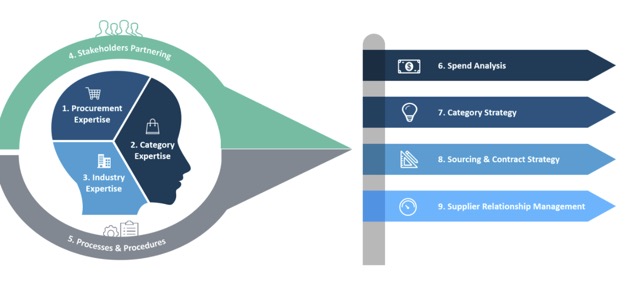Are you really employing Category Management effectively?
Procurement categories are a grouping of materials or services that have similar supply and usage characteristics to meet business objectives. Category management is different from the “strategic sourcing process”. The latter is typically an n-step process, starting with procurement-led analysis and ending with a preferred supplier contract. Many companies favor a process-based sourcing process today, but unfortunately many also lack a true category management structure, that is essential for it to be effective.
Category management is a framework and set of practices that sits above and guides the content and sequencing of lower-level methodologies like strategic sourcing and supplier relationship management. It evaluates not only the full life cycle of a contract or supplier life cycle, but also looks holistically at the life cycle of the value chains which consider the goods and services in the spend categories. It involves building a clear understanding of the organization’s key value objectives for the category based on continuous communication and dialogue with business stakeholders.
The determinants of value are a direct function of stakeholder mapping, feedback, and performance criteria that become the foundation for managing supplier relationship performance across the global enterprise. Effective category strategies drive business process innovation with key suppliers, which in turn drive business value, using a Total Cost of Ownership approach that identifies non-value added activities, increased transparency, and improved end customer satisfaction.

Category management is most definitely not about putting a new veneer on the strategic sourcing methodology. If procurement can be viewed as a service provider, category management becomes the primary service line, and category managers are essentially solutions assemblers who deploy the appropriate solutions/services required by budget owners. Tyco International goes so far as to call them “Category CEOs”.
What defines a world class supply chain organization that leverages a category management structure?
The following are the key attributes that define best-in-class companies who leverage a category management approach. We have been able to develop a benchmarking process that utilizes AI to conduct best-in-class performance in each of these areas, as part of the SC Maturity Model approach.
- Category Segmentation – Clear segmentation of categories in a logical fashion that is aligned with supply markets, not by internal customer usage characteristics. Category managers serve as a single point of contact for supplier relationships that all fall into the same form of demand requested by internal LOB’s.
- Category Strategies – Well-documented category strategies with performance scorecards, supplier risk indices, business continuity plans, value drivers, and quarterly supplier reviews; strategies are well communicated, engage stakeholders across the enterprise, and tie to annual LOB budgetary targets.
- Market Intelligence – Processes are in place to gather supply market intelligence from across the organization, suppliers & external sources on a regular basis that feed into a centralized category leadership team, responsible for enterprise-wide supplier management
- Centers of Excellence – providing global support services for supply market intelligence, predictive analytics, supplier scorecards, supplier risk reporting and monitoring, and cross-enterprise global economic planning reports that support supply market planning (e.g. country-specific risk incidents, currency projections, regulatory updates, etc.)
- Governance – Clear governance over sourcing decisions, with business unit representation on team decisions, quarterly category reviews with Supply Chain Executive Council and direct line to enterprise leadership teams when confronted with major conflicts as they arise on an as-needed basis
- Category Manager Competencies – Capability development for category managers that span not just commodity-specific technical knowledge, but commercial capabilities, analytical, networking, and communication skills that drive broad enterprise-wide perspectives on managing the category. The core competencies of a category manager include: market intelligence, strategic thinking, relationship management, program management, change management, cross-functional team facilitation, executive interaction, and ongoing leadership
The category management approach involves many different activities, but can provide value-driven outcomes, that go beyond simply driving price savings!


